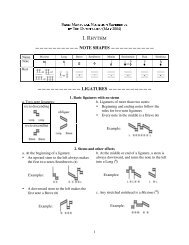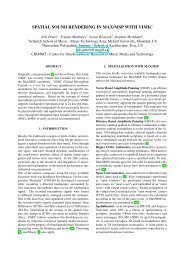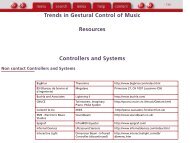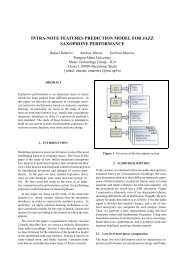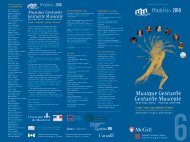Sound Kitchen: Designing a Chemically Controlled Musical - CiteSeer
Sound Kitchen: Designing a Chemically Controlled Musical - CiteSeer
Sound Kitchen: Designing a Chemically Controlled Musical - CiteSeer
You also want an ePaper? Increase the reach of your titles
YUMPU automatically turns print PDFs into web optimized ePapers that Google loves.
Proceedings of the 2003 Conference on New Interfaces for <strong>Musical</strong> Expression (NIME-03), Montreal, Canada<br />
which point it shuts down. It controls a simple additive synthesis<br />
patch of two sounds with 4 partials each. The base<br />
frequency of one sound is equal to f1 =x, while that of the<br />
other is f2 =x − (x/5), where x is the signal value. These<br />
two sounds produce a beating effect, which increases as both<br />
values diverge. This signal is used throughout the piece, providing<br />
its overall form (Figure 7, the bottom part) with the<br />
top value achieved at 2<br />
softheduration of the piece, and<br />
3<br />
the remainder 1<br />
showing a different behavior during cooling<br />
3<br />
down.<br />
Signal 3 + 4: Morning Bird & Meshscape<br />
Signals 3 and 4 are derived from the Pouring Battery. It controls<br />
a patch producing 50 ms bursts of an additive synthesis<br />
array whose bandwidth, base frequency and preeminence of<br />
each partial’s weight depend on various scaling of signals 3<br />
and 4. It provides what is perceived as a background bird<br />
singing sound which tends to be stronger when the quantity<br />
and motion of electrolyte inside the battery is higher, that is,<br />
during pouring, with an immediate decay in presence (lower<br />
pitch height and intensity).<br />
This signal also controls an additive synthesis and frequency<br />
modulation patch. Volume is controlled by slow<br />
transient envelope taking up to 30 seconds to peak. The additive<br />
synthesis patch produces a mesh of 16 partials whose<br />
weight is scaled by three oscillators which also modulate the<br />
frequency of 3 other partials. The rhythm achieved with<br />
the liquid pouring influences the rate of oscillation, inducing<br />
higher sidebands that appear to match the movement of<br />
the performer.<br />
Figure 8: The score: its duration is 3 to 8 minutes<br />
depending on the start temperature of water. Drawings<br />
indicate location of group events in a timeline.<br />
Acoustic Signals 1 - 4<br />
The direct sound of baking soda diluted in vinegar inside test<br />
tubes of different sizes is sent across the room in a 4-channel<br />
spatialization setup controlled via a pd patch. This process<br />
has a short duration and defines the start point every time a<br />
scoop of baking soda isadded to the tube. It appears along<br />
the beginning, reaching the climax, and at the end of the<br />
piece.<br />
4.2 Score and Performance<br />
The system was tested in December 2002 with a composition<br />
for which a simple score (Figure 8)wasdesigned.<br />
The three authors participated asperformers stirring juice,<br />
pouring water + wine in the batteries, baking sodatotubes,<br />
and otherwise, supervising that the whole system responded<br />
NIME03-86<br />
as expected throughout the performance. With practice, a<br />
single performer may be sufficient for the whole act.<br />
As to not affect the impression that the visual performance<br />
is integrally bounded to the output sound, no manipulation<br />
of the Pd patch, nor the microcontroller board is<br />
required (except for a few start/stop instructions throughout<br />
the performance)<br />
While this system was designed with an specific outcome<br />
in mind, there are few constraints for it to be used as a<br />
more general performance system. Most of the limitations<br />
are posed by the choice of audio synthesis and parameters<br />
in the design of the Pd patch, and the capture/conditioning<br />
stage in the microcontroller. This choices are completely<br />
arbitrary, and respond mostly to the initial compositional<br />
idea. A different user with Pd and avrgcc programming<br />
experience could modify this framework with a minimum<br />
effort, but that also brings the question of whether it would<br />
not be more effective to build a different one from scratch.<br />
5. CONCLUSION AND FUTURE WORKS<br />
The exploration of music creation with chemical reactions<br />
and manipulations is a novel topic in the field of computer<br />
music. Through simple chemical experimentations, analog<br />
circuitry, computer manipulation, and human control, a new<br />
way of creating music has been explored. Since making music<br />
using chemicals has not been vastly explored, there remains<br />
great potential for further improvement in this area.<br />
One method of improvement would be to implement some<br />
sort of real time automatic normalization of the chemical<br />
signals. Currently the system hastobetuned to prevailing<br />
conditions (ambient temperature, electrolyte mixture)<br />
before performance. Furthermore, it is possible to explore<br />
other chemicals, reactions, and control methods that can<br />
allow for other musically inspiring signals and performance<br />
situations. Finally, this project is truly a testament of the<br />
integration of diverse fields of study to create new music.<br />
6. ACKNOWLEDGMENTS<br />
We would like to thank Max Mathews, Bill Verplank,<br />
Michael Gurevich and Wendy Ju for their advice and support.<br />
7. REFERENCES<br />
[1] Kramer et al: Sonification Report: Status of the Field<br />
and Research Agenda. Prepared for the National<br />
Science Foundation by members of the International<br />
Community for Auditory Display. (1996)<br />
Available online at<br />
http://www.icad.org/websiteV2.0/References/nsf.html<br />
[2] CCRMA, Music 250A home page:<br />
http://www-ccrma.stanford.edu/courses/250a/<br />
[3] Atmel AVR home page:<br />
http://www.atmel.com/atmel/products/prod23.htm<br />
[4] OSC is a protocol for communication among computers,<br />
sound synthesizers and other multimedia devices that is<br />
optimized for modern networking technology.<br />
OSC home page:<br />
http://cnmat.cnmat.berkeley.edu/OSC/<br />
[5] Pd (Pure Data) is a real-time graphical programming<br />
environment for live interactive computer music. Pd<br />
works on SGI machines, Microsoft Windows, Linux,<br />
and Mac OSX. Pd home page:<br />
http://crca.ucsd.edu/ msp/software.html





